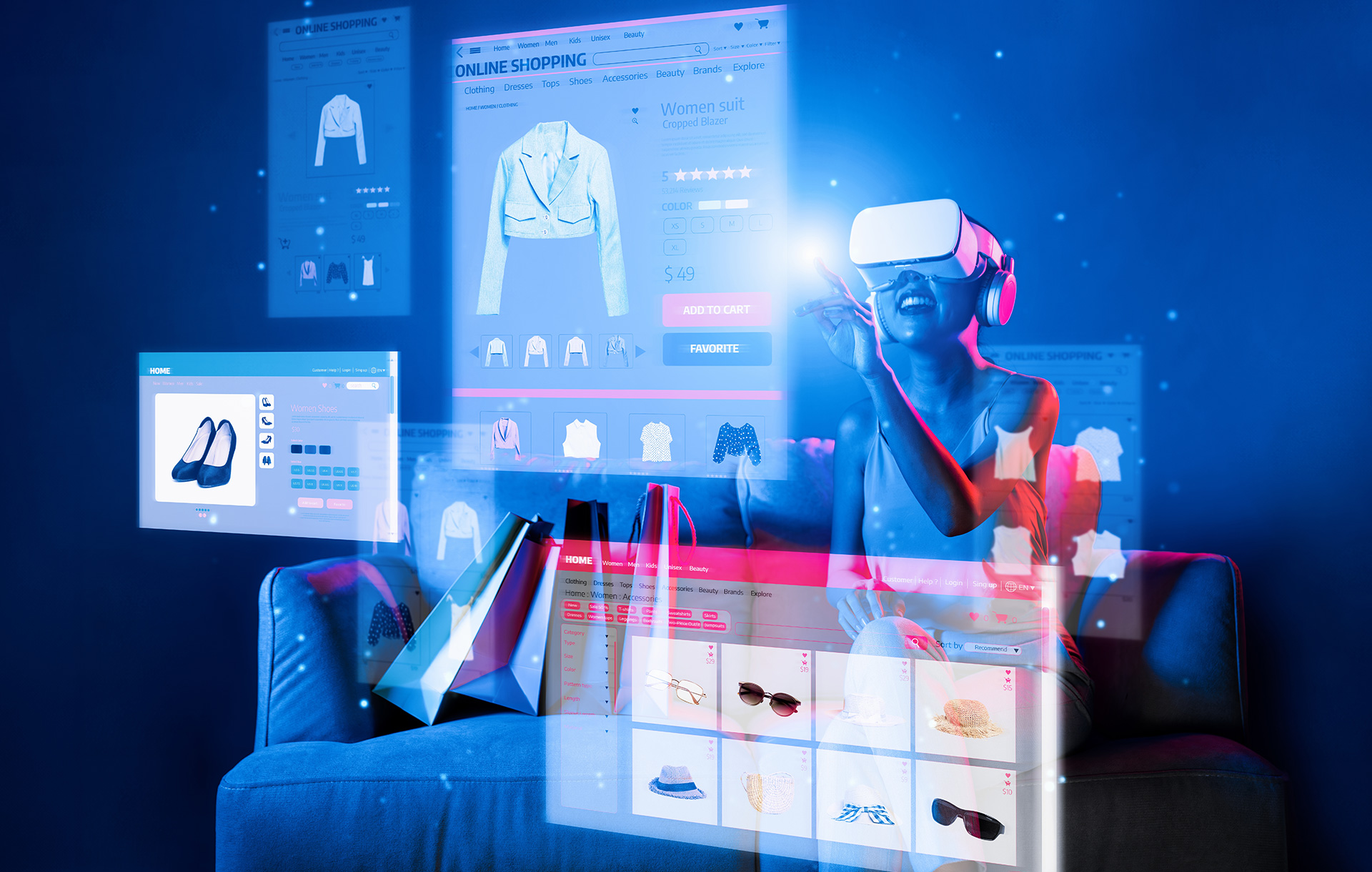8 Prime Ecommerce Design Trends for Supreme Customer Experience In 2023
#ICYMI, e-commerce has been booming in recent times. So much so that the sales generated in 2022 amounted to approximately over $5 trillion. With 5.16 billion of the world’s population online, it’s easy to imagine how this monumental figure is so easily attainable.
Given that the industry is still growing and developing, it leaves a lot of opportunities for brands to leverage the potential that exists. The simplest way to do so is by identifying market trends and finding ways to incorporate them into your e-commerce strategy.
Given that tie is of the essence, we’ll dive straight in – starting with a few facts and figures to paint a clearer picture of the e-commerce landscape and also reveal the top retail design trends 2023.
The influence of eCommerce design on consumer behaviour
When it comes to eCommerce shopping experience the online shopping experience, the design needs to be almost flawless. It needs to be easy to use and navigate while still looking aesthetically pleasing. You cannot compromise on functionality for beauty, nor can you put beauty on the back burner for a site that functions optimally.
The reason for this is simple, if it doesn’t look good, people will not even take the time to see if your product is worthwhile. Once the look of it hooks the user, it’s time to look at the functionality from a user’s perspective to ensure that everything is where you need it to be and that all the tools are available to process the online sale.
10 eCommerce design stats you need to know in 2023
- 60% of all retail sales in the UK come from mobile users – this is more than anywhere else in Europe!
- It’s projected that there will be almost 285 million online shoppers in 2025
- 2 months is the average turnaround time for a simple website build
- 88.5% of web designers and developers believe that a slow site is the main reason visitors leave a page
- 42% of consumers say that they’ll leave a website if it doesn’t function as it should
- 38% of consumers believe that page layout and navigational links should be prioritized when building a website
- 27% of small businesses do not have a website rel=”noopener noreferrer” – yet
- 42.7% of online users use an ad blocker to rel=”noopener noreferrer” enhance their online experience
rel=”noopener noreferrer”
- 53 of users will refresh a page if it takes longer than 3 seconds to load
- 73% of consumers trust a business’s website more than any other online source
eCommerce design trends for 2023
When it comes to e-commerce web design trends for 2023, there are so many components that need to be considered. The first part relates to retail design trends for 2023 and how the retail space is constantly evolving both in the real world and online. This also looks at the product design trends for 2023 as well as global events that can shape consumer purchase decisions.
All things considered, there are a few interesting trends set to take over in 2023, let’s take a look!
1. Menus that are vertically aligned
The norm has always been to have horizontal menu bars; however, this is quickly changing. This is because most users will use the site on their mobile devices with a portrait screen. For a mobile-friendly approach, implementing a vertical menu is a great first step.
2. Combining digital and reality
eCommerce stores offer an effective way to shop for the latest products as well as discover new brands. However, for those looking to visit a physical store, e-commerce is the link that can bring the two together by allowing users to find nearby locations as well as check current stock quantities.
3. Unusual layouts
Another great way to stand out is to give your website a unique, yet functional design. This promotes user engagement and encourages repeat visitors.
4. Voice recognition technology
To further simplify the online shopping experience, voice search functionality is here to save the day. Users can simply tell the website what they’re looking for and have it pop up almost instantly. Simple and effective, right?
5. A more personalised experience
This trend is evident everywhere, personalisation matters. People want to feel special and not like just another foot in the door. So wherever possible, try to offer a tailored user experience.
6. Bridging the gap between markets
Many brands have taken note of the potential that exists when you expand your reach beyond that of your online store. Integrate with other apps and link up with online marketplaces to expand your reach.
7. A sensory experience
Allow your online space to be a fully immersive experience by trying to awaken each of the senses. From a simple ding when making a purchase to unique fonts and on-screen animations – the options are endless!
8. Go green
Consumers are gravitating to more eco-friendly practices. Online shopping is a green alternative when it comes to shopping as it reduces the need for travel or gas while also saving valuable time. While this is a good thing to promote, it goes far beyond this. Your packaging needs to be eco-friendly, and your operations need to be beneficial to the surrounding community and the environment in which it operates.
9. Sustainability
An increasing number of customers are becoming conscious of how their purchases impact the environment. eCommerce retailers are responding by adopting sustainable practices and showcasing their sustainability initiatives on their websites. These initiatives include reducing waste, using sustainable materials, minimising carbon emissions, and promoting eco-friendly products. Sustainability has also become a key factor in the purchasing decisions of consumers, with many willing to pay more for products that are environmentally friendly. As a result, retailers that prioritise sustainability are not only doing their part to protect the environment, but they are also appealing to a growing segment of environmentally conscious consumers.
10. Chatbots
Chatbots provide customers with a more convenient and personalized way to get assistance with their shopping. Chatbots are AI-powered virtual assistants that can communicate with customers in natural language, answering frequently asked questions, providing product recommendations, and even completing transactions. Chatbots can also collect customer data, such as preferences and purchase history, to provide a more personalised shopping experience. By using chatbots, retailers can improve customer service, reduce response times, and increase sales.
11. Interactive user interfaces
Interactive user interfaces create a more engaging and memorable shopping experience for customers. Interactive user interfaces use animations, hover effects, and other interactive elements to provide customers with a more immersive and interactive way to browse products. For example, a hover-over effect that shows the product from different angles or a clickable feature that provides more information on the product can help customers better understand the product and make a more informed purchase decision. Interactive user interfaces can also improve customer engagement and reduce bounce rates, leading to increased conversions and sales.
12. Personalisation
Retailers seek to provide a more tailored and relevant shopping experience for customers. Personalisation involves using customer data, such as browsing history, purchase history, and demographic information, to provide personalised product recommendations, targeted advertising, and personalised promotions. By delivering personalised content, retailers can increase customer engagement and loyalty, leading to increased sales and revenue. Personalisation can also help retailers to differentiate themselves from competitors and build stronger relationships with customers.
13. Dynamic product displays
Dynamic product displays are a popular eCommerce design trend that uses animation and interactivity to showcase products in a more engaging and immersive way. Dynamic product displays can include features such as 360-degree product views, interactive videos, and zoomable images, allowing customers to view products from different angles and get a better sense of the product’s features and benefits. By providing a more engaging and interactive experience, dynamic product displays can improve customer engagement, reduce bounce rates, and increase conversions and sales.
14. Minimalism
Finally, minimalism is a popular customer experience retail design trend that uses a clean, simple, and uncluttered approach to design. Minimalist eCommerce websites typically feature a lot of white space, simple typography, and a focus on essential elements. By simplifying the design, minimalist eCommerce websites can provide a more streamlined and efficient shopping experience for customers. This approach reduces distractions, improves navigation, and focuses the customer’s attention on the products being sold. Additionally, minimalist eCommerce websites load faster, which can improve the user experience and reduce bounce rates.
The time has come to make a change
What are you waiting for? Seriously… You should be coming up with ways to incorporate the above-mentioned eCommerce website trends so that your business can stand a chance in the impending e-commerce boom that will change the world of shopping as we know it.
If you need some time to figure it out and perhaps a bit of help, why not reach out to us and let our team assist you with the latest eCommerce web design trends?
This blog post is Last updated on May 24th, 2023.
Subscribe To Us
Contributors
Categories
Subscribe To Us
Contributors
Categories

This website uses cookies so that we can provide you with the best user experience possible. Cookie information is stored in your browser and performs functions such as recognising you when you return to our website and helping our team to understand which sections of the website you find most interesting and useful. Third party cookies such as Google Analytics is also used on this site to provide analytics in order to better understand the user engagement on our site.
You can adjust all of your cookie settings by navigating the tabs on the left hand side.
Strictly Necessary Cookie should be enabled at all times so that we can save your preferences for cookie settings.
If you disable this cookie, we will not be able to save your preferences. This means that every time you visit this website you will need to enable or disable cookies again.







0.Comments